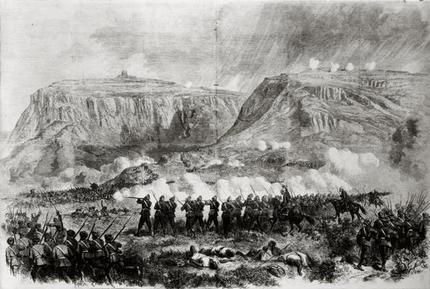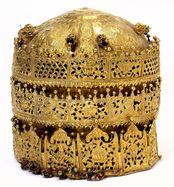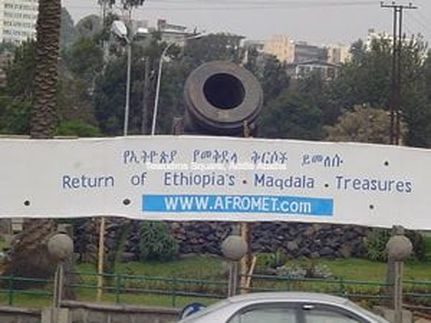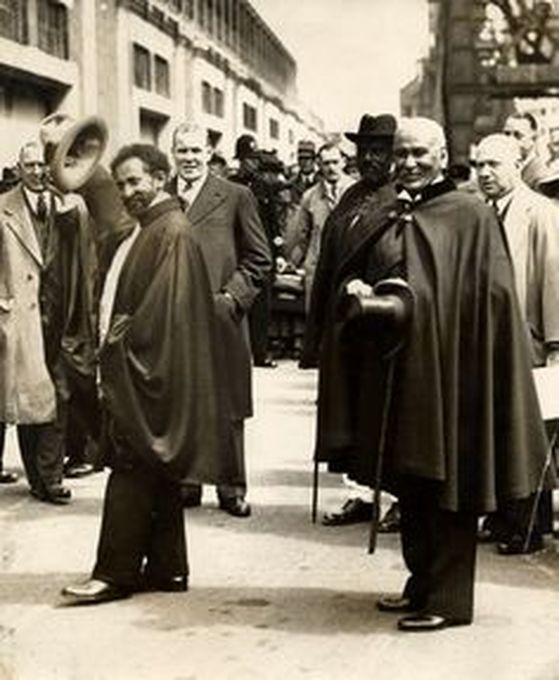The Book Liberator
The Maqdala Campaign

In 1841 Negus Sahela Sellassie of Shoa and Queen Victoria of Britain signed a treaty of friendship and commerce. But when, in 1868, a letter addressed to Queen Victoria went unanswered, Emperor Tewodros II detained some British subjects residing in the Kingdom.
Lord Napier led an expedition of British and Indian troops against the Emperor and stormed his fortress at Magdala, plundering treasures as well as 350 manuscripts from the library of the Church of the Redeemer of the World. Tewodros II is said to have committed suicide.
Lord Napier led an expedition of British and Indian troops against the Emperor and stormed his fortress at Magdala, plundering treasures as well as 350 manuscripts from the library of the Church of the Redeemer of the World. Tewodros II is said to have committed suicide.

Much of the booty from Maqdala was distributed via direct and indirect channels to various British museums. In August 1872 Emperor Yohannes IV wrote to Queen Victoria requesting return of a Kebra Negast (Glory of Kings) taken from Magdala and the British Museum complied four months later. When Regent Ras Tafari (later to be crowned Emperor Haile Selassie I) visited Britain in 1924 the British treasury scrambled to gift to the Ethiopian government one of two stolen crowns, described by officials as “rather barbaric headgear”.

During the 1980s, Ras Seymour Mclean, Chaplain of the Ethiopian World Federation, resident in London, attempted to liberate the Magdala manuscripts by means of direct action. In 1999 the Association for the Return of the Maqdala Ethiopian Treasures (AFROMET) was inaugurated in Addis Ababa. It's chair was Andreas Eshete, and amongst its prominent members were Ras Seymour and Sylvia Pankhurst's children Richard and Rita.
During the 1980s, Ras Seymour Mclean, Chaplain of the Ethiopian World Federation, resident in London, attempted to liberate the Magdala manuscripts by means of direct action. In 1999 the Association for the Return of the Maqdala Ethiopian Treasures (AFROMET) was inaugurated in Addis Ababa. It's chair was Andreas Eshete, and amongst its prominent members were Ras Seymour and Sylvia Pankhurst's children Richard and Rita.
Three captives from Maqdala
Prince Alemayehu
The son of Emperor Tewodros II, Prince Alemayehu was taken by Captain Speedy an English officer, back to Britain, at seven years old. Prince Alemayehu lived at Speedy's house in the Isle of Wight and there met Queen Victoria who became his ward. One picture below shows Speedy and Prince Alemayehu posing in a forced intimacy, with the older man dressed in orientalist garb and the young boy entirely sorrowful. The Queen described Prince Alemayehu as polite and graceful with "nothing whatever of the Negro about him.” However, Prince Alemayehu continually asked to be returned home. The Prince died aged 18 from pleurisy , contracted when he moved to Leeds. He was buried at Windsor Castle and his bones still remain there.
Hakim Wärqenäh Eshäté (Dr Charles Martin)
Hakim Wärqenäh Eshäté was only 3 years old when he lost both parents at Magdala, themselves captives of Emperor Tewodros II. The young child was taken by the British military as a ward under Colonel Charles Martin and sent to India for education. At some point he took on his ward's name for himself. Eshäté eventually returned to Ethiopia. When, in 1925, the British and Italian consulates unilaterally came to agreement over their interests in Lake Tsana, Ras Tafari sent Eshäté to negotiate directly with the United States over this strategic natural resource. It is through Eshäté that African Americans first came to know about the contemporary - rather than biblical - Ethiopia. When Italian aggression threatened the kingdom in 1934, Haile Selassie I sent Eshäté to London to head the Ethiopian legation.
Hakim Wärqenäh Ešaté greets Haile Selassie I on the emperor's arrival to Britain, June 1936
Emir Ali
A cousin of Emperor Menelik II, Emir Ali was also ‘saved’ by the British army at Maqdala and entrusted to Captain Speedy. However, Ali left Britain within one year as a ward of the ship’s captain of the Star of India. Speedy's family at this point in time had settled in Aotearoa New Zealand. Speedy himself took part in the land wars against the indigenous people, the Māori, just before signing on to the Napier expedition to Ethiopia. Perhaps, then, it was the information provided by Speedy that led Emir Ali to depart for the land of the "long white cloud". He eventually arrived in Auckland in 1874 where he was to remain for the rest of his life. An elderly Emir Ali provided newspaper commentary in New Zealand on the lead up to the Italian war against Ethiopia in 1935.
We have yet to find a picture of Emir Ali
